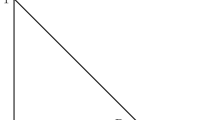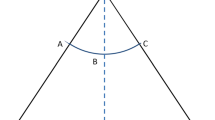Abstract
One of the significant topics in intuitionistic fuzzy set (IFS) is the measure of the distance between IFSs. Although distance measures on IFSs have been widely studied in previous studies, there are few studies about the generation of them. In this paper, a quaternary function called intuitionistic fuzzy dissimilarity function is proposed to construct distance measures on IFSs. Two methods for building intuitionistic fuzzy dissimilarity functions are presented. The first one is obtained by combining dissimilarity functions and fuzzy equivalencies. The second one is obtained based on constructing new intuitionistic fuzzy dissimilarity functions through other existing ones. We also examine and compare some properties of intuitionistic fuzzy dissimilarity functions, through which we obtain some properties of distance measures on IFSs. Some examples of pattern recognition are applied to illustrate the effectiveness of the proposed distance measures on IFSs.
Similar content being viewed by others
References
Atanassov KT (1986) Intuitionistic fuzzy sets. Fuzzy Sets Syst 20:87–96
Atanassov KT (1999) Intuitionistic fuzzy sets. Springer, Heidelberg
Boran FE, Akay D (2014) A biparametric similarity measure on intuitionistic fuzzy sets with applications to pattern recognition. Inf Sci 255:45–57
Burillo P, Bustince H (1996) Entropy on intuitionistic fuzzy sets and on interval-valued fuzzy sets. Fuzzy Sets Syst 78:305–316
Bustince H, Burillo P, Soria F (2003) Automorphisms, negations and implication operators. Fuzzy Sets Syst 134:209–229
Bustince H, Barrenechea E, Pagola M (2008) Relationship between restricted dissimilarity functions, restricted equivalence functions and normal \(E_N\)-functions: image thresholding invariant. Pattern Recognit Lett 29:525–536
Chen SM (1995) Measures of similarity between vague sets. Fuzzy Sets Syst 74(2):217–223
Chen SM (1997) Similarity measures between vague sets and between elements. IEEE Trans Syst Man Cybern 27(1):153–158
Chen TY (2007) A note on distances between intuitionistic fuzzy sets and/or interval-valued fuzzy sets based on the Hausdorff metric. Fuzzy Sets Syst 158:2523–2525
Chen SM, Chang CH (2015) A novel similarity measure between Atanassov’s intuitionistic fuzzy sets based on transformation techniques with applications to pattern recognition. Inf Sci 291:96–114
Chen SM, Cheng SH, Lan TC (2016) A novel similarity measure between intuitionistic fuzzy sets based on the centroid points of transformed fuzzy numbers with applications to pattern recognition. Inf Sci 343–344:15–40
Fodor JC, Roubens M (1994) Fuzzy preference modelling and multicriteria decision support. Kluwer Academic Publishers, Dordrecht
Grabisch M, Marichal JL, Mesiar R, Pap E (2009) Aggregation functions, Encyclopedia of Mathematics and Its Applications 127. Cambridge University Press, Cambridge
Grabisch M, Marichal JL, Mesiar R, Pap E (2011a) Aggregation functions: means. Inf Sci 181:1–22
Grabisch M, Marichal JL, Mesiar R, Pap E (2011b) Aggregation functions: construction methods, conjunctive, disjunctive and mixed classes. Inf Sci 181:23–43
Grzegorzewski P (2004) Distances between intuitionistic fuzzy sets and/or interval-valued fuzzy sets based on the Hausdorff metric. Fuzzy Sets Syst 148:319–328
He XX, Li YF, Qin KY, Meng D (2017) On the \(T_L\)-transitivity of fuzzy similarity measures. Fuzzy Sets Syst 322:54–69
Hong DH, Kim C (1999) A note on similarity measures between vague sets and between elements. Inf Sci 115:83–96
Hung WL, Yang MS (2004) Similarity measures of intuitionistic fuzzy sets based on Hausdorff distance. Pattern Recognit Lett 25:1603–1611
Hung WL, Yang MS (2007) Similarity measures of intuitionistic fuzzy sets based on \(L_p\) metric. Int J Approx Reason 46:120–136
Hung WL, Yang MS (2008) On the \(J\)-divergence of intuitionistic fuzzy sets with its application to pattern recognition. Inf Sci 178:1641–1650
Klement EP, Mesiar R, Pap E (2000) Triangular norms. Kluwer Academic Publishers, Dordrecht
Kolesárová A (2001) Limit properties of quasi-arithmetic means. Fuzzy Sets Syst 124(1):65–71
Li F, Xu ZY (2001) Similarity measures between vague sets. J Softw 12(6):922–927 (in Chinese)
Li DF, Cheng CT (2002) New similarity measures of intuitionistic fuzzy sets and application to pattern recognitions. Pattern Recognit Lett 23:221–225
Li YF, Qin KY, He XX (2013) Relations among similarity measure, subsethood measure and fuzzy entropy. Int J Comput Intell Syst 6(3):411–422
Li YF, Qin KY, He XX (2014) Some new approaches to constructing similarity measures. Fuzzy Sets Syst 234:46–60
Li YF, Qin KY, He XX (2015) Dissimilarity functions and divergence measures between fuzzy sets. Inf Sci 288:15–26
Li YF, He XX, Qin KY (2016a) Relationships among several fuzzy measures. In: Papakostas GA, Hatzimichailidis AG, Kaburlasos VG (eds) Handbook of fuzzy sets comparison: theory, algorithms and applications. Science Gate Publishing, Thrace, pp 43–78
Li YF, Qin KY, He XX, Meng D (2016b) Robustness of fuzzy connectives and fuzzy reasoning with respect to general divergence measures. Fuzzy Sets Syst 294:63–78
Liang ZZ, Shi PF (2003) Similarity measures on intuitionistic fuzzy sets. Pattern Recognit Lett 24:2687–2693
Liu XC (1992) Entropy, distance measure and similarity measure of fuzzy sets and their relations. Fuzzy Sets Syst 52:305–318
Montes I, Pal NR, Janis̆ V, Montes S (2015) Divergence measures for intuitionistic fuzzy sets. IEEE Trans Fuzzy Syst 23(2):444–456
Montes I, Pal NR, Janis̆ V, Montes S (2016) Local divergences for intuitionistic fuzzy sets. IEEE Trans Fuzzy Syst 24(2):360–373
Papakostas GA, Hatzimichailidis AG, Kaburlasos VG (2013) Distance and similarity measures between intuitionistic fuzzy sets: a comparative analysis from a pattern recognition point of view. Pattern Recognit Lett 34(14):1609–1622
Szmidt E, Kacprzyk J (2000) Distances between intuitionistic fuzzy sets. Fuzzy Sets Syst 114:505–518
Wang PZ (1983) Fuzzy sets and its applications. Shanghai Science and Technology Press, Shanghai (in Chinese)
Wang WQ, Xin XL (2005) Distance measure between intuitionistic fuzzy sets. Pattern Recognit Lett 26:2063–2069
Xu ZS, Chen J (2008) An overview of distance and similarity measures of intuitionistic fuzzy sets. Int J Uncertain Fuzziness Knowl Based Syst 6(4):529–555
Ye J (2011) Cosine similarity measures for intuitionistic fuzzy sets and their applications. Math Comput Model 53:91–97
Zadeh LA (1965) Fuzzy sets. Inf Comput 8:338–353
Zhang HM, Yu LY (2013) New distance measures between intuitionistic fuzzy sets and interval-valued fuzzy sets. Inf Sci 245(10):181–196
Acknowledgements
This research is supported by the National Natural Science Foundation of China (Grant Nos. 61603307 and 61473239), the Fundamental Research Funds for the Central Universities (Grant Nos. JBK170134 and JBK150503) and the Grant from MOE (Ministry of Education in China) Project of Humanities and Social Sciences (Grant No. 19YJCZH048).
Author information
Authors and Affiliations
Corresponding author
Ethics declarations
Conflict of interest
The authors declare that they have no conflict of interest.
Ethical approval
This article does not contain any studies with human participants or animals performed by any of the authors.
Additional information
Communicated by V. Loia.
Publisher's Note
Springer Nature remains neutral with regard to jurisdictional claims in published maps and institutional affiliations.
Rights and permissions
About this article
Cite this article
He, X., Li, Y., Qin, K. et al. Distance measures on intuitionistic fuzzy sets based on intuitionistic fuzzy dissimilarity functions. Soft Comput 24, 523–541 (2020). https://doi.org/10.1007/s00500-019-03932-5
Published:
Issue Date:
DOI: https://doi.org/10.1007/s00500-019-03932-5




